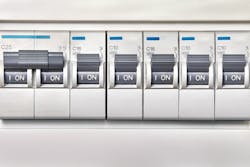Before central air-conditioning, electric ranges, and large refrigerators, single-family residences were built with a 30A service that used fuses. When a fuse would blow, the “savvy” homeowners would stick a penny in the fuse slot until they could swing by the hardware store and buy a replacement fuse. Not being as savvy as they imagined themselves to be, they would sometimes forget about this temporary fix and ultimately need to call an electrician to replace the damaged wiring.
A similar temporary quick fix often takes place in industrial settings due to pressure to get equipment running. When you don’t have the correct overcurrent protection device (OCPD) in stock, going the next size up can protect against a fault but not against an overload.
If the OCPD is expected later in the day, this may be an acceptable risk; just don’t use something that can handle more current than the conductors can handle. To prevent the forgetting part, set up a DMM or other instrument to measure the current and task someone with recording its readings hourly.
About the Author

Mark Lamendola
Mark is an expert in maintenance management, having racked up an impressive track record during his time working in the field. He also has extensive knowledge of, and practical expertise with, the National Electrical Code (NEC). Through his consulting business, he provides articles and training materials on electrical topics, specializing in making difficult subjects easy to understand and focusing on the practical aspects of electrical work.
Prior to starting his own business, Mark served as the Technical Editor on EC&M for six years, worked three years in nuclear maintenance, six years as a contract project engineer/project manager, three years as a systems engineer, and three years in plant maintenance management.
Mark earned an AAS degree from Rock Valley College, a BSEET from Columbia Pacific University, and an MBA from Lake Erie College. He’s also completed several related certifications over the years and even was formerly licensed as a Master Electrician. He is a Senior Member of the IEEE and past Chairman of the Kansas City Chapters of both the IEEE and the IEEE Computer Society. Mark also served as the program director for, a board member of, and webmaster of, the Midwest Chapter of the 7x24 Exchange. He has also held memberships with the following organizations: NETA, NFPA, International Association of Webmasters, and Institute of Certified Professional Managers.
